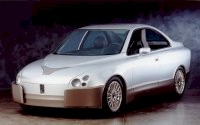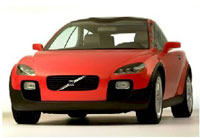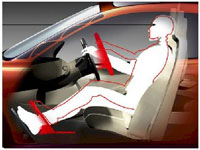|
Eye Position Sensors
In
November 2000, Volvo and Ford Motor Company announced their concept car called
EyeCar. The EyeCar
ensures adequate visibility for all drivers by adjusting the position
of the drivers eyes to a standard position within the vehicle via an
automated motorized seat. It also adjusts the steering wheel, brake and accelerator pedals
to match the drivers position.
Volvo uses two different technologies in its "fixed-eye
position system" to determine the location of the driver's eye.
- The
first step in determining the position of the eye takes less than a
second. It uses a video camera positioned in the interior of the car
above the windshield to scan the driver's seat area to find the driver's
head and face to pinpoint
the location of the driver's eyes and body.
Since lighting conditions in the car may vary the camera is equipped with its own
infrared light source, a source invisible to the human eye which ensures sufficient
lighting for interpretations. After the eyes are identified, the camera registers
the reflexes of the eyes and their unique pattern of reflected light. These readings
are then compared with pre-programmed patterns by on-board computers which then
proceed to adjust the seat, pedals, steering column, handbrake lever and floor to
match the optimal height of the seat.
- A
second sensor, in the roof, measures the electric field directly
above the driver's seat. The water content of the driver's body will alter the field's
pattern. The sensor measures the changes and uses them to determine the distance
between the top of the drivers head and the sensor itself. The seat can then be accurately
adjusted so that the
top of the driver's head is 7.5 centimeters below the roof
to optimize the driver's field of vision.
In January, 2001, Volvo expanded its fixed-eye positioning system with its Safety
Concept Car's theme of "superior
vision."
This unique positioning system would be beneficial to our project by providing
us knowledge of which area of the windshield is directly in front of each driver.
|
 Product
Product
 Liquid Crystals
Liquid Crystals Moth-eye Gratings
Moth-eye Gratings Photonic Crystals
Photonic Crystals Laws
Laws
 Manufacturing
Manufacturing


